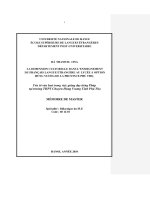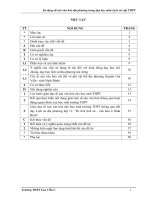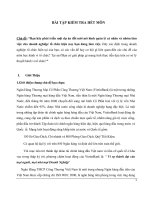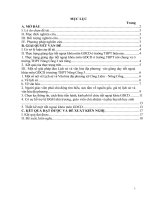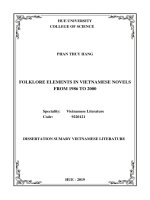(Skkn 2023) lồng ghép các yếu tố văn hoá địa phương vào việc giảng dạy tiết học communication and culture sách giáo khoa tiếng anh 10 (global success)
Bạn đang xem bản rút gọn của tài liệu. Xem và tải ngay bản đầy đủ của tài liệu tại đây (1.56 MB, 27 trang )
SÁNG KIẾN KINH NGHIỆM
INTEGRATING LOCAL CULTURAL FACTORS IN TEACHING
COMMUNICATION AND CULTURE LESSON – ENGLISH 10
(GLOBAL SUCCESS)
LỒNG GHÉP CÁC YẾU TỐ VĂN HOÁ ĐỊA PHƯƠNG VÀO VIỆC GIẢNG
DẠY TIẾT HỌC COMMUNICATION AND CULTURE - SÁCH GIÁO KHOA
TIẾNG ANH 10 (GLOBAL SUCCESS)
MÔN: TIẾNG ANH
Năm học 2022 - 2023
------------------
SỞ GIÁO DỤC VÀ ĐÀO TẠO TỈNH NGHỆ AN
TRƯỜNG THPT CHUYÊN PHAN BỘI CHÂU
SÁNG KIẾN KINH NGHIỆM
INTEGRATING LOCAL CULTURAL FACTORS IN TEACHING
COMMUNICATION AND CULTURE LESSON – ENGLISH 10
(GLOBAL SUCCESS)
LỒNG GHÉP CÁC YẾU TỐ VĂN HOÁ ĐỊA PHƯƠNG VÀO VIỆC GIẢNG
DẠY TIẾT HỌC COMMUNICATION AND CULTURE - SÁCH GIÁO KHOA
TIẾNG ANH 10 (GLOBAL SUCCESS)
Tác giả:
Nguyễn Thị Thanh Mỹ
Đặng Thị Kim Oanh
Tổ:
Ngoại ngữ
Điện thoại: 0979 935 999 - 0915 127 558
Đơn vị:
Trường THPT chuyên Phan Bội Châu
Năm học 2022 - 2023
---------------
TABLE OF CONTENT
PART 1: INTRODUCTION................................................................................... 1
1.1. Rationale............................................................................................................. 1
1.2. Aims and objectives ........................................................................................... 1
1.3. Scope of the study .............................................................................................. 1
1.4. Significance of the study .................................................................................... 2
PART 2: CONTENT ............................................................................................... 3
2.1. Theoretical background ...................................................................................... 3
2.1.1. The concept of culture ..................................................................................... 3
2.1.1.1. Definition ..................................................................................................... 3
2.1.1.2. The relationship between language and culture ........................................... 3
2.1.2. The importance of teaching culture to language learners ............................... 4
2.2. How to integrate local cultural factors into teaching communication and
culture lesson effectively........................................................................................... 4
2.2.1. The overview of the textbook English 10 (Global success) ........................... 4
2.2.2. Methodology ................................................................................................... 5
2.2.2.1. Research setting............................................................................................ 5
2.2.2.2. Participants ................................................................................................... 6
2.2.2.3. Methods and instruments ............................................................................. 6
2.2.3. Findings and discussions ................................................................................. 6
2.2.3.1. Necessity of the study ................................................................................. 6
2.2.3.2. Feasibility of the study ................................................................................. 7
2.2.3.3. Some suggested adaptations to integrate local cultural factors into teaching
communication and culture lesson ............................................................................ 8
PART 3: CONCLUSION ..................................................................................... 23
3.1. Study review ..................................................................................................... 23
3.2. Limitations and suggestion for further study ................................................... 23
REFERENCES ...................................................................................................... 24
PART 1: INTRODUCTION
1.1. Rationale
In the past few decades, the field of English Language Teaching has started to
emphasize the linguistic and cultural diversity rather than focusing only on teaching
aspects related to the English language. Therefore, cultural awareness has become an
integral part of English classrooms. The need for cultural awareness cannot be ignored
and in order to make communication sufficient, it needs to be accompanied by
multidimensional cultural awareness since communication almost never exits culture free.
In Vietnam, however, the role and status of culture in language teaching has
always been a challenging issue for teachers. Their conception and opinion may be very
different regarding the meaning of culture and the possibilities of incorporating cultural
content into the language teaching process. These differences can result from their
previous experience as language learners, from what they have learnt along their
training process, and from the various possibilities they have had to come into direct
contact with the target culture. The cultural content taught in language classes may also
be influenced by the extent of differences between the native and target cultures.
Compared to grammar or vocabulary, culture is more difficult to define; therefore, it is
not clear what and how should be taught.
However, we strongly believe that some principles, recommendations, and
practical ideas regarding the introduction of cultural content must be included in
the curriculum of language teaching methodology. Teacher trainees need to
develop a theoretical and practical awareness of what culture means and in what
forms it may be present in the language classroom.
As teachers of English, we are well-prepared to meet this challenge. In order
to raise students’ awareness of culture in general and local culture in particular, we
have been motivated to do a research into “Integrating local cultural factors into
teaching communication and culture lesson in the textbook English 10-Global
Success”.
1.2. Aims and objectives
This study investigates how to integrate local cultural factors into teaching
communication and culture lesson effectively.
1.3. Scope of the study
This study will be carried out in a local high school among the population of
10th graders. This study will be restricted to language learners using the textbook
English 10-Global Success in their English classes, which focus on communication
and culture lessons. Thus, the findings are limited to this population and context.
1
Further studies among different levels of students or courses could yield more
information and techniques on how this application could be used to its fullest to
benefit student’s learning experience in a holistic way.
1.4. Significance of the study
The present study has significance for future practice, research and policy.
The results of this study could be used by several groups of teachers. The findings
might assist EFL teachers in improving the design of their lessons.
2
PART 2: CONTENT
2.1. Theoretical background
2.1.1. The concept of culture
2.1.1.1. Definition
The word ‘culture’ has a very broad concept, embracing all aspects of human
life. Samovar, Porter, and McDaniel (2010) have stated that culture has five main
components which can distinguish one culture from another. They are history,
religion, values, social organizations and language. A history of an area can build
the identity and behavior of the history’s owners. Similarly, the influence of
religion and values can be seen in every aspect of the culture that makes the
owners of that culture have rules to follow; social organizations such as families
and communities, and government also reflect our culture and language is an
essential element in order to help in culture transmission. Culture can be learned,
shared and passed down from generation to generation, based on symbols and
dynamic integrated systems.
In a broad sense, culture refers to what people believe, what people think,
what people create, and the like. In a narrow sense, culture means an identifiable
group with shared beliefs and experiences, feeling of worth and value embedded in
the experience and shared interest in a common historical background (Brislin,
19981:2).
In terms of the types of culture, Appelbaum (1997) proposes two aspects of
human culture, namely material culture and non-material culture. Material culture
concerns ‘all physical objects made by the members of a particular society to assist
in shaping their lives’. They include technological devices, goods consumed, the
place of worship, types of cuisine, offices, stores, vehicles, and the like. Nonmaterial culture deals with the ideas shared by people in a particular society which
includes language, values, beliefs, customs, habits, rules, conventions, institutions,
organizations, and others. Such types of culture have to be taken into account when
English language teachers carry out the process of English language teaching and
learning.
2.1.1.2. The relationship between language and culture
According to Nault (2006, p. 314), “Language and culture, it could be said,
represent two sides of the same coin”. Many researchers have found close
relationships between language and culture whereby language and culture mutually
reflect each other hence the language is a reflection of the culture and the culture is
reflected in the language. Liddicoat, Papademetre, Scarino and Kohler (2003) have
argued that language and culture are closely related to each other, a language is
part of a culture, and culture is part of a language. The linkage between them
cannot be separated, if so, the benefits of one of them will then be lost. Through
the use of language we can understand the values, beliefs, and perspectives that
3
exist in a culture. On the other hand, when we consider the language as
communication, language cannot be separated from the cultural context in which
the communication occurs. Without knowledge of the culture, it would be difficult
to understand meanings in the language (Seelye, 1993).
2.1.2. The importance of teaching culture to language learners
Language education researchers have classified different types of cultural
contents in language lessons to suit the purposes of their study. Kramsch (1995),
for example, discusses three different “links” between language and culture.
Universal links imply the culture that can be shared by various language speakers
across social and national boundaries. National links refer to the cultures separated
by the national boundaries such as French “civilization or English “culture”. Local
links are related to the culture expressed through the words and actions of everyday
speakers in everyday life. Cortazzi and Jin (1999) categorize three types of cultural
information that can be represented in language lessons: the target culture, the
source culture and the international culture. The target culture exposes learners to
the culture of countries where the language they are learning is spoken as the first
language. Learning the target culture, learners may be more interested in learning
the language, or develop positive attitudes towards these language-speaking people
and countries. The source culture draws on the learners’ own culture. This culture
can help students to develop a positive cultural identity.
2.2. How to integrate local cultural factors into teaching communication and
culture lesson effectively
2.2.1. The overview of the textbook English 10 (Global success)
The Vietnam Education Publishing House has compiled the English 10 Global Success - Student's book in accordance with the "General education
program: English subject program" from grade 3 to grade 12. This program was
issued through Circular No. 32/2018/TT-BGDDT on December 26, 2018, by the
Ministry of Education and Training. The book follows a series of English books
for primary school (English 3, English 4, English 5) and English for secondary
school (English 6, English 7, English 8, English 9).
The English 10 - Global Success - Student's book has been designed in a
communicative manner to help students develop their ability to communicate in
English. This is achieved through the use of corpus (sounds, vocabulary, and
grammar), in the four forms of listening, speaking, reading, and writing.
Additionally, the book has been designed in a learner-centered way to promote the
activeness and initiative of students. All teaching activities have been organized to
create optimal conditions for students to participate in activities that help them
practice and develop their English communication ability.
The English 10 - Global Success - Student's book has been designed to
integrate skills, with a focus on developing reading, speaking, listening, and
4
writing skills that complement each other. The book revolves around four themes
that are relevant to student engagement: Our Lives, Our Society, Our Environment,
and Our Future. These themes are explored in ten lesson units, each of which
corresponds to a specific topic. After each topic, there is a review section that is
aimed at training language knowledge and further developing language skills that
students have already learned.
The English 10 - Global Success - Student's book in general and
Communication and culture in particular places a significant emphasis on the
cultural characteristics of Vietnam, English-speaking countries, and countries
worldwide. The book has been compiled to help supplement and enrich students'
background knowledge in various areas of social life. Therefore, the integration of
local cultural factors into these lessons will make the target more achievable.
BOOK MAP- COMMUNICATION AND CULTURE -ENGLISH 10
(GLOBAL SUCCESS) AND SOME SUGGESTED ADAPTATIONS
UNIT
COMMUNICATION AND CULTURE
Unit 1: Family life
Family values in the UK
Unit 2: Humans and the environment
Carbon footprint
Unit 3: Music
Chau Van singing
Unit 4: For a better community
Save the Children organization
Unit 5: Inventions
Computer hardware
Unit 6: Gender equality
Women’s football
Unit 7: Vietnam and international FAO and its activities to support Vietnam
organizations
Unit 8: New ways to learn
Modern schools
Unit 9: Preserving the environment
Earth Hour
Unit 10: Ecotourism
Tourism impact on the environment
2.2.2. Methodology
2.2.2.1. Research setting
The academic year 2022-2023 is the first time that The English 10 - Global
success has been implemented in almost all schools of Nghe An province. How to
fully exploit this textbook is the question raised at many teaching conferences, as
thus, there is a need to assist both teachers and students alike in achieving the
teaching and learning objectives. A survey was carried out with the aim of finding
the necessity and the feasibility of integrating local cultural factors into
Communication and Culture lesson.
5
2.2.2.2. Participants
Thirty teachers of English coming from different high school of Nghe An
province namely: Phan Boi Chau high school for the gifted, Huynh Thuc Khang
high school, Ha Huy Tap high school, Le Viet Thuat high school, Boarding high
school for Ethnic minorities were involved in the study. Most of them have over
10-year experience of teaching English, yet they find it quite challenging as to how
to teach communication and culture lesson effectively.
2.2.2.3. Methods and instruments
The researchers have conducted a questionnaire dealing with the four-level
necessity and feasibility of the study. Teachers taking part in the survey were given
the link to express their own opinions.
a. Survey Questionnaire
A set of questionnaire consisting of 5 questions were used to gather opinions
on teachers’ response to the necessity and feasibility of integrating local cultural
factors into teaching communication and culture lesson.
The forms were constructed with Google Forms and distributed online. A
statistical analysis was derived from the Google Form apps and the analysis was
thoroughly performed.
2.2.3. Findings and discussions
2.2.3.1. Necessity of the study
Four out of five questions concerning necessity were raised in the survey. The
results of the questionnaires were tabulated by Google form apps.
Questions
1. How do you evaluate
the integration local
cultural elements into
teaching the
Communication and
Culture ?
2. How do you evaluate
the students’ preparation
for local cultural
materials before lessons?
Less
Very
Neccessary
Unneccessary
neccessary
neccessary
N
%
N
%
N
%
N
%
18
60
9
30
3
10
0
0
15
50
8
26,7
6
20
1
3,3
6
3. How do you evaluate
the importance of
integrating local cultural
elements, which helps
students understand the
native culture and better
absorb the target
language?
22
73.33
4. How do you evaluate
the teachers' preparing
materials on local culture
for their lessons?
24
80%
6
5
20
2
6,67
0
0
16, 7
1
3,3
0
0
It can be shown that 27 out of 30 teachers involved in the study agree that it is
very necessary or necessary (accounting for 60 % and 30 % respectively) to
integrate local cultural factors into teaching communication and culture lesson.
In response to question 2, most of the correspondents find it important to ask
students to get prepared for the relevant learning materials before class, with only
3,3 % seeing no point in doing this.
When it comes to the benefits that this method can bring about, well under
three fourths (making up 73.33 %) express their strong approval of exploiting it to
achieve the learning objectives, that is, help students understand the native culture
and better absorb the target language.
When asked about the importance of teachers’ preparation for the local
cultural teaching materials, almost all of the surveyed teachers rated this as very
necessary or necessary.
2.2.3.2. Feasibility of the study
Very
feasible
5. How do you evaluate the
feasibility of applying the
initiative "Integrating local
cultural factors into
teaching communication
and culture lesson in the
textbook English 10-Global
Success" in practical
teaching?
Feasible
Less
Feasible
Feasible
N
%
N
%
N
%
N
%
18
60
10
33,3
2
6,7
0
0
7
As regards to the last question, a majority of the surveyed teachers (18
respondents accounting for 60 %) believe that it is very feasible to apply this
technique into teaching this lesson. A quite considerable proportion (well over one
third of teachers involved) voice their positive attitudes towards the
implementation of the method.
From the data analysis, it motivates researchers to suggest some adaptations
from the source material (the English 10 textbook – Global Success) by means of
integrating local cultures features.
2.2.3.3. Some suggested adaptations to integrate local cultural factors into
teaching communication and culture lesson
There exist several ways of delievering the lessons that teachers can employ
to make them more memorable and effective. Therefore, the activities in the
communication and culture can be carried out by means of working in individual,
in pairs or in groups. It is also advisable that the teacher should be flexible in either
assigning the learners themselves to make presentations in class or the teacher
himself/ herself preparing some suitable learning materials such as videos,
pictures, handouts, etc….
a. Student preparation for the class presentation
Learners are assigned one-week preparation for a class presentation of the
target aspect of culture. After each presentation, questions for discussions will be
raised so that the learners will have to have an insight into the target aspect of the
culture.
Sample 1: Unit 3: MUSIC:
Target language (the textbook): CHAU VAN singing
Suggested adaptation: VÍ DẶM folk song
Vi-Dam folk song is the traditional music genre of Nghe An and Ha Tinh
provinces in the central region. It plays a very important part in cultural and
spiritual life of local people in these two provinces. They are idyllic lyrics and
sweet melodies about daily or working activities such as growing rice, weaving,
etc. as well as honoring parental love, love between girl and boy, love for country,
etc. This traditional folk song has great value of culture, art and humanity. On
November 27th2014, UNESCO officially recognized Vi-Dam Folk Song as an
intangible cultural heritage of humanity at the 9th session of its InterGovernmental Committee for the Safeguarding of the Intangible Cultural Heritage
in Paris. Vi-Dam Folk Song is the ninth intangible cultural heritage of Vietnam.
Hence, so as for the students to have a better understanding of this proud local
music, teachers have asked students to make a presentation.
8
9
10
11
Sample 2: Unit 4: FOR A BETTER COMMUNITY
Target language (the textbook): Save the children organization
Suggested adaptation: Voluntary organizations in Nghe An and
students’ activities
It is common knowledge that volunteering helps improve mental and physical
health, and taking time to get away from studies while doing something
meaningful can often be the mental reset students need. Getting involved with
volunteering from a young age encourages students to become socially-minded
individuals at every stage in life.
In recent years, Phan Boi Chau high school for the gifted are not only known for
roaring academic successes but also boast many meaningful community services.
Among them are their voluntary activities in SOS, which aid homeless and
disadvantages children there. With the aim of raising students’ awareness and
getting more students to get involved in this voluntary organization: VÌ TIẾNG
CƯỜI TRẺ THƠ.
12
13
14
15
Sample 3: Unit 6: GENDER EQUALITY
Target language (the textbook): Women’s football
Suggested adaptation: Vietnamese Women’s Football
The Vietnam women's national football team is a women's football team
representing Vietnam and controlled by Vietnam Football Federation. This is the
most successful women's football teams in Southeast Asia and ranks 5th in Asia.
Vietnamese Women’s football has been a source of inspiration and pride of
Vietnam, showing that Vietnamese can obtain great achievements beyond
imagination with their passion, efforts and mental fortitude. Hence, it would be a
great idea for students to have a better understanding of Vietnamese Women’s
football in terms of history, achievements, etc…via a language class.
b. Teacher preparation for the lessons
With the aim of helping students to understand more about the different aspects of
local culture, teachers exploited a myriad of methods and employing a wide variety
of learning materials: videos, pictures, handouts, etc… Some suggested adaptations
are as follows:
Sample 4: Unit 1: FAMILY LIFE
Target language (the textbook): Family values in the UK
Suggested adaptation: Family values in Vietnam
Procedures:
Teacher distributes the handout to students and asks them to read the
information and make a comparison between Family values in the UK and
Family values in Vietnam. Some representatives will deliver their talk after
10-minute preparation.
16
HANDOUT:
FAMILY VALUES IN VIETNAM
Vietnamese traditional values were deeply affected by Confucian ethics. During
thousand years under the invasion and domination by Chinese, Vietnamese culture
was also permeated by their Confucian philosophical beliefs. It was believed that
“in order to achieve human perfection, one must follow the established codes of
behavior which include reverence for ancestors and respect for elders…The
importance is not upon the individual’s accomplishments but upon his duty to
family and society”
Most Vietnamese placed more emphasis on their roles, privileges and obligations
within this group than on their own individual desires. The Vietnamese household
traditionally followed the extended multi-generational pattern. The parents, their
sons and their wives, their children, and unmarried siblings usually constituted a
Vietnamese household. In this extended family, the most important expectation was
the respect for the elders. Hence, the family decisions were made by the parents and
grandparents.
For centuries in Vietnam, traditional family values were accomplished by the
fulfillment of traditional roles the role of man and woman as parents. The
Vietnamese people value humility, restraint, and modesty. The Vietnamese culture
has a great respect for the elderly. In every situation, it is best to give honor and
preference to the eldest member of the group.
17
Sample 5 : Unit 9: PROTECTING THE ENVIRONMENT
Target language (the textbook): Earth Hour
Suggested adaptation: Earth Hour in Vietnam
Procedures: Students are supposed to read the text given in the textbook
and complete the table containing the fact file about Earth Hour. Then, the
teacher gets students to watch a video on Earth Hour in Vietnam and
afterwards asks students to answer the follow-ups questions
- Do you want to take part in this lights-out event in Vietnam? Why or why
not?
- If you had a chance to take part in the event held in your city, Vinh City,
what would you do?
Earth Hour is a worldwide movement organized by the World Wildlife Fund. The
event is held annually, encouraging individuals, communities, and businesses to
turn off non-essential electric lights, for one hour from 8:30 to 9:30 p.m., usually
on the last Saturday of March, as a symbol of commitment to the planet. Vietnam
first joined the event in 2009 and has been an active and keen supporter since then.
/> />
18
Sample 6: Unit 1: ECOTOURISM
Target language (the textbook): Tourism impact on the environment
Suggested adaptation: Kinds of tourism in Vietnam
Procedures: First, students are supposed to read the text given in the
textbook about four popular types of tourism and put them into categories in
the table according to their negative or positive impact on the environment.
Then the teacher may integrate some famous local tourism destinations to
check students’ understanding
Option 1: Teacher gives a number of pictures (some famous tourist
attractions in Vietnam) and asks student where the destination is, then
labelling whether it is mass tourism, ecotourism or sustainable tourism)
Expected answer: Hoi An ancient town, Quang Nam –Mass tourism
19
Expected answer: Sam Son beach, Thanh Hoa province – Mass tourism
20
Expected answer: Trang An Landscape Complex, Ninh Binh – Ecotourism /
Sustainable tourism
Expected answer: Quan Ho folk singing on boat, Bắc Ninh – Sustainable
tourism
Option 2: Teacher gives some hints/ clues about some sustainable tourism
locations in Vietnam and asks students to guess what it is
HA LONG BAY
Hint 1: It was recognized by UNESCO as a World Natural Heritage in
1994.
Hint 2: Its name means "descending dragon”
Hint 3: It belongs to Quang Ninh province, Vietnam
21
CAI RANG Floating market, CAN THO
Hint 1: It is a special kind of market as the shops and stalls at the market are boats
of different sizes.
Hint 2: It is one of the most famous and biggest floating markets in the Mekong
Delta.
Hint 3: It belongs to Can Tho City, Vietnam
22



